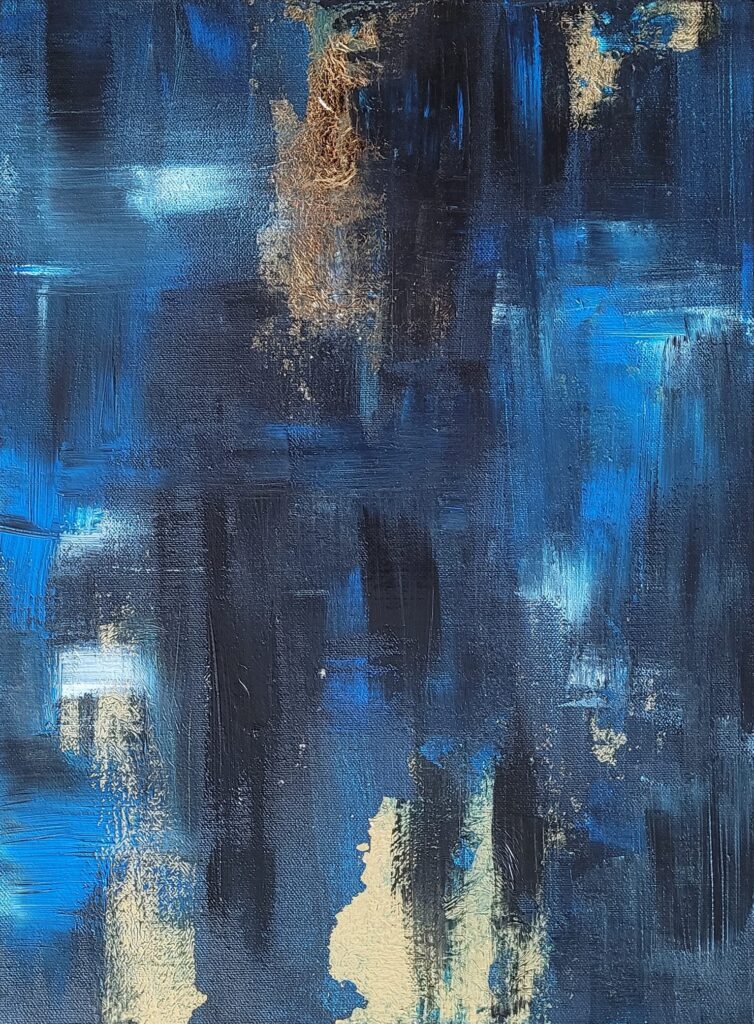Taking part to new exhibitions is always a great pleasure. Especially when your work has been selected. Tthanks to the curatorial team of Florence Contemporary Gallery
In the era of the pandemic when everything seems falling apart, art helps. Art is the curative, ‘magic’, golden substance that puts together the pieces that have been breaking in due course. And this ‘power’ has no limits.
That is what I really believe and that is what I put inside the painting which was selected for thus groupshow. ‘Kintsugi’ (photo below).
‘Kintsugi’ and so the other two paintings of the series ‘Shadows’, were born after a thoughtful and intense thinking process. In those paintings and in the following series that I will in fact call ‘Kintsukuroi’ I intent to compare the process of making art with the Japanese spirituality, philosophy, and technique of ‘Kintsugi’.
Related to this view and to the BAC’s new magazine issue which I am curating and around the theme of Spirituality, I have prepared the following text, born initially as slides of a presentation that I had the pleasure to discuss with the collective. I invite you to have a read and to let me know what you think.
To visit the exhibition please go to https://www.florencecontemporary.com/limitless

(From a presentation of a talk with the Bookmark Collective around Spirituality)
THE VALUE OF BROKEN THINGS
«The damage of something broken does not need to be hidden but valorised, remembered and made something affected by it ARTFUL» MDG.
KINSTUKUROI AND KINSTUGI:
the beauty of the zen practice
Kintsugi, or gold splicing, is a physical manifestation of resilience. … This practice—also known as kintsukuroi (金繕い ), which literally means gold mending—emphasizes the beauty and utility of breaks and imperfections (https://qz.com/1347017/the-japanese-art-principle-that-teaches-us-to-expose-our-failures-not-cover-them-up/)
Whichever kind of art artists love and practice, or whatever they believe to be spiritual or not spiritual means, it remains: the inspiration, the research, the wiliness, and the art practice itself, the process creates “something else.” The conjunction between art and life, inside and outside, perfect and imperfect, broken or entire, is the wabi-sabi of life. The definition found on Wikipedia is the following: “in traditional Japanese aesthetics, wabi-sabi is a world view centred on the acceptance of transience and imperfection. The aesthetic is sometimes described as one of appreciating beauty that is ‘imperfect, impermanent, and incomplete’ in nature”.
My idea of spirituality in art as well as in life is very much close to the zen’s philosophy of the Kintsugi. ‘Kintsugi’ belongs to the Zen ideals of wabi sabi, which cherishes what is simple, unpretentious, and aged. The following story is told of one of the great proponents of wabi sabi, Sen no Rikyu (1522-99).
“On a journey through southern Japan, he was once invited to a dinner by a host who thought he would be impressed by an elaborate and expensive antique tea jar that he had bought from China. But Rikyu didn’t even seem to notice this item and instead spent his time chatting and admiring a branch swaying in the breeze outside. In despair at this lack of interest, once Rikyu had left, the devastated host smashed the jar to pieces and retired to his room. But the other guests more wisely gathered the fragments and stuck them together through kintsugi. When Rikyu next came to visit, the philosopher turned to the repaired jar and, with a knowing smile, exclaimed: ‘Now it is magnificent’”. (https://www.theschooloflife.com/thebookoflife/kintsugi/)
THE PHILOSOPHY
“The Zen philosophy always emphasises the impermanence and uncontrollability of nature […] While fixing things can create another form of beauty, we should learn a lesson from the Japanese, and this would help to solve the problem of wastefulness in consumer culture”. (Pui Ying Kwan)
Art practise is, philosophically speaking, artists’ “kintsugi” of life, the “golden paste” that they can use to put broken pieces together, be them caused by unpredictable or predictable events. (MDG)
ART AS KINTSUGI PRACTISE OF LIFE
Everyone has different reasons for making art. But a common one is because they feel inspired by something internal or external, and it makes artists feel better when they practice it!
“As Pablo Picasso once said, “Art washes from the soul the dust of everyday life.” Art encourages creative thinking, enhances problem-solving skills, boosts self-esteem and provides a sense of accomplishment”.
Alvaro Montagna –unorthodox
But first and foremost, ART makes the world’s imperfections beautiful and it “puts together its broken pieces”MDG
BIBLIOGRAPHY ON KINTSUGI
- https://www.theschooloflife.com/thebookoflife/kintsugi/
- https://books.google.co.uk/books?id=LZcXEAAAQBAJ&pg=PA158&lpg=PA158&dq=the+spirituality+of+kintsugi+pdf&source=bl&ots=upG8Np_nI8&sig=ACfU3U1VyoWOQrTuYVMTV7ypyQX8DO4UfA&hl=en&sa=X&ved=2ahUKEwjpkvax4PDwAhXvB2MBHay5DdIQ6AEwEXoECA8QAw#v=onepage&q=the%20spirituality%20of%20kintsugi%20pdf&f=false
- Keulemans, Guy. “The Geo-Cultural Conditions OfKintsugi.” The Journal of Modern Craft 9, no. 1 (2016): 15–34. doi:10.1080/17496772.2016.1183946
- https://static1.squarespace.com/static/5f7cdffa51ea0d248ec7710c/t/5f9f47751458eb762c361662/1604274093582/Salty+Vol+03+-+Joseph+Weaver.pdf
- http://museum.cornell.edu/exhibitions/aesthetics-mended-japanese-ceramics



